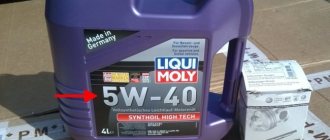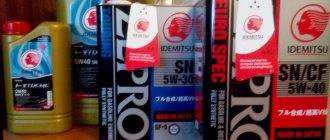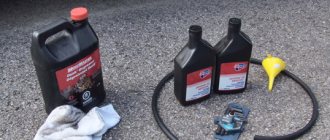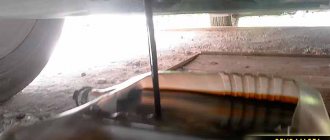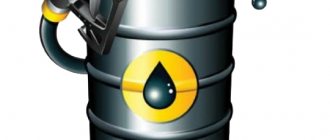The procedure for changing transmission fluid is similar to changing engine oil and begins with warming up, for which we drive several kilometers, after which we do not operate the car for 10-15 minutes. If this is neglected, the test will show an incorrect level of residual fluid. To work comfortably with a manual transmission, you need a platform, an inspection hole or at least a high-quality jack, a container for testing, and it is also advisable to have a special syringe. In the case of automation, gasoline or solvent is useful for washing parts.
Manual transmission
When the preparatory stage is completed and the car is on the handbrake, open the hood and look for the dipstick, which on front-wheel drive cars is usually located in the front part of the engine, and on rear-wheel drive cars, respectively, in the rear, next to the engine shield. Some models are not equipped with such a meter, and the level is measured with something like a piece of wire.
Having pulled out and wiped the dipstick with a rag, we measure the remainder to understand how much needs to be added to the max mark. After this, unscrew the drain plug, placing a bucket in advance.
Next, pour fresh oil through a watering can. If, due to design features, it is difficult to get to the hole with your hands, we use a syringe.
Which gear oil to choose for a modern car? And is it necessary to think about what was poured into his box and when?
Why replace something that lasts a lifetime? Optimism goes away when you discover in the backyard of a service station a mountain of dead manual and automatic transmissions taken from cars of one very well-known company. Which? Well, it doesn’t matter... The important thing is that boxes have now become almost disposable! They try not to repair them, but to replace them entirely - how much would such a replacement cost without a warranty, can you estimate? Therefore, the box must be cared for and cherished and be sure to be pampered with good oil. It is best to use a fully synthetic one, viscosity class 75W-90, API GL-4 quality class - this is perfect for manual transmissions.
It’s a pity that we don’t see domestic transmission synthetics on the shelves. Only imports are mainly European, mainly German. Instead of GL-4, manufacturers prefer to indicate GL-4+, GL-4/5, and GL-3/4/5. So we bought a dozen of them. The price ranges from the affordable 345 rubles for a liter jar of Dutch NGN to 775 rubles for the French Motul Gear 300. Is it worth overpaying? That's why we arranged an examination.
Draining oil through the plug
Let's merge! If your box has a drain plug at the bottom, first place some large container under it. Usually, its role is played by cut-off plastic canisters, taking into account that several liters of fluid will come out of the transmission (about 3 to 5). Next, unscrew this drain plug and oil will flow out of the neck by gravity. And now you just have to wait until all the liquid that can leak out, accordingly, flows out. After this, screw the drain plug back on. Count the amount of oil drained from the transmission - you will now need to pour the same amount of new fluid inside.
How to check the oil level in an automatic transmission
WHY DID YOU CHECK?
And here is what it all started for. We officially declare: the oils are very different and clearly not from the same barrel. The difference in results for individual parameters is not by percentages, but by several times! And the effect does not always correspond to the price. The leader was immediately revealed - the ester Motul Gear 300 has the best performance in terms of welding load, scuffing index, and critical load. The wear is a little worse, but here it’s generally interesting: none of the tested oils met the GOST requirements for the TM-5 group. Why is that? Perhaps this is a consequence of a decrease in the content of sulfur and phosphorus in modern products, which previously determined high anti-wear properties. But the result obtained cannot be considered negative either: we choose oil for manual transmissions of the GL-4 group, where anti-wear indicators are not standardized at all by GOST.
And here is another nuance that was worth working for. It turned out that anti-wear and extreme pressure properties change in antiphase! At the level of intuition this is understandable. The basic principle of wear protection is to place something soft and sliding between the parts. To increase scuff resistance, the opposite is required. Therefore, an effective additive package must provide some compromise between two mutually exclusive factors.
Well, what's better? Our advice on the topic “What to choose?” - below. We have arranged the files of all participants in alphabetical order. But I have one wish: not about oils.
WHAT, HOW AND WHY WE MEASURED
Tribological parameters. Characterize the protective properties of oil during contact in gears. They are determined in accordance with GOST 9490–75 on a four-ball friction machine: three stationary steel balls at the bottom, one spins at a given speed at the top and a load presses on it. The structure is immersed in an oil bath in which the test oil splashes. And then the behavior of the balls and contact patches tells everything. For different types of transmission oils, it is standardized by our GOST 17479.2–85; there are generally accepted ways of interpreting the results of such tests. Of course, foreign manufacturers are not required to follow GOST, but we live in Russia, and therefore we can use the standards of this document to assess the quality of oil.
Critical load. This is the threshold for destruction of the oil film. GOST does not standardize its value, so let’s think simply: the higher it is, the better.
Scuffing and wear. The main troubles of gearing. They are characterized by a scuffing index and a wear index. The index is not standardized - in general, the higher the better. The wear rate for GL-4 oils (TM-4 in our GOST) is not standardized, but for TM-5 (or GL-5 in our non-our language) it should be no more than 0.4 mm. In general, the less the better.
Welding load. The main parameter by which extreme pressure properties are standardized. It is defined simply: the balls are loaded and loaded until the friction machine stops. For TM-4 oils, the welding load must be no less than 3000 N, for TM-5 - 3280 N. Let's take these numbers as an evaluation criterion.
Viscosity. At operating temperatures, we evaluate the kinematic viscosity, and at low temperatures, the dynamic viscosity. Using kinematic viscosity at 40 and 100 °C, we calculate the viscosity index, which characterizes the degree of dependence of viscosity on temperature. The range of changes in this viscosity at 100 °C for the 75W‑90 class is quite wide - from 13.5 to 24 cSt. The higher the viscosity at operating temperature, the heavier the motor, generally speaking. The lower the dynamic viscosity at negative temperatures, the faster the box will warm up and the better the car will drive.
Pour point. Everything is simple here: the lower, the better.
Flash point. Together with the pour point, it characterizes to a certain extent the stability and quality of the base oil. The higher it is, the better the base usually is, which means you can expect that the resource of such oil will be longer.
QUESTION ANSWER
Are these types of oils suitable for automatic transmissions?
No good. Special fluids with different properties have been created for automatic transmissions. Here it is very important to follow the recommendations of the manufacturer, because ATF fluid ensures the operation of the torque converter, which requires strictly specified viscosity-temperature characteristics. And for manual transmissions these requirements are much more relaxed.
What is the difference between GL-4 and GL-5 oils? Or, in our opinion, TM-4 from TM-5?
According to GOST 17479.2–85, the purpose of TM-4 group oils is cylindrical, spiral-bevel and hypoid gears operating at contact stresses up to 3000 MPa and oil temperature in the volume up to 150 °C. And the recipients of TM-5 oils are hypoid gears operating with shock loads at contact stresses above 3000 MPa and bulk oil temperatures up to 150 °C. Hence the differences in the required protective properties discussed in the article. Therefore, in particular, switching from GL-4 to GL-5 and back is unacceptable: these are different oils with different properties.
Will using a more viscous oil reduce transmission noise?
Yes, it will reduce it if the noise is caused by increased gaps in the box components. But within reasonable limits, of course. With a high degree of wear, even the most viscous oil will not help.
Should I chase synthetics? Or is the situation the same as with motor oil?
Synthetics are more stable and therefore guarantee a longer service life. In addition, it has a higher viscosity index, so the low-temperature properties of such oils are better. So there is a certain analogy with motor oils.
Why are there such large numbers in the SAE designations if the weather outside is the same as for the engine?
The numbers indicate the average viscosity range for the oil grade in Saybolt Second Universal Unit (SSU). For transmissions they are taken directly, for motors they are divided in half.
Functions of transmission oil, what is the difference between engine and transmission oil
Most car owners know about the need to regularly change engine oil. But what is usually forgotten is that the gearbox oil also wears out over time and should be replaced to avoid damage to the transmission. Which, ultimately, will cost much more than changing the oil in the gearbox.
REPRESENTATIVES
ADDINOL Gear Oil GH 75W-90
Germany
Price 1 liter - 420 rub.
SAE 75W-90, API GL-4/GL-5
Approvals: MIL-L-2105D, VW 501 50
There is not a word in Russian on the label! One of the serious advantages is one of the highest levels of wear protection. But there is a fly in the ointment: modest results in terms of the scuffing index and welding load. And low-temperature properties are not the best.
— Relatively low protective properties against scuffing.
BP Energear SGX 75W-90 Winner in the Wear Protection category
Belgium
Price 1 liter - 470 rub.
SAE 75W-90, API GL-4+
Approval: Suitable for VW 501 50
The wear protection is the best and the scuff protection is worse than most. In terms of wear, it comes very close to the very strict GOST requirements for oils of a higher group - TM-5. Good low temperature properties and highest flash point.
+ Best wear protection, affordable price.
— Low values of the scuffing index.
Castrol Syntrax Universal Plus
Germany
Price 1 liter - 550 rub.
SAE 75W-90, API GL-4/GL-5 & MT-1
Approvals: MAN 3343S, 341E3; Scania STO 1:0; MB-Approval 235.8; ZF TE-ML 02B, 05B, 12B, 16F, 17B, 19C, 21B; SAE J2360
One of the best protection against welding is combined with satisfactory wear protection. Very low pour point - with the lowest viscosity index. At the same time, the highest flash point promises a long service life.
+ High welding load provides long-term protection against scuffing; low pour point.
— Low viscosity index.
Eurol Lubricants Transyn Synthetic
Netherlands
Price 1 liter - 420 rub.
SAE 75W-90, API GL-3/4/5 & MT-1
Approvals: Meets ZF TE-ML 01, 02, 05, 07, 08, Volvo 97310, Scania STO 1:0 BOX; MAN 341 TL/341 Type Z-3; MAN 342 SL/342 Type S-1; MAN 3343 S/SL; MIL-L-2105 B/C/D; MIL-PRF-2105E; DAF ZF TE-ML 02 BOX.
Again, not a single Russian word on the can! But in the “not our” language, on the one hand it is written in large letters that it is synthetic, and on the other, in much smaller print, it is semi-synthetic... What to believe? After the tests, we believe the second one more.
+ High welding load, even according to our strict GOST it passes as TM-5.
- Worst wear indicator.
JB GERMAN OIL Hypoid Getriebeoel GL 4 plus Winner in the category “Wear protection”
Germany
Price 1 l - 520 rub.
SAE 75W-90, API GL-4/GL-5 & MT-1
Approvals: MAN 3343 Type S; Scania STO 1:0; ARVIN MERITOR 0-79-N; SAE J2360; MIL-PRF-2105E; ZF TE-ML 02B, 05B, 07A, 12B, 16F, 17B, 19C DAF IVECO
One of the leaders in the number of approvals from automakers, but it’s not clear from the description - “approved” or “complies”? Wear protection is excellent, and the scuff index is weak. Low temperature characteristics are on par. And at the same time the highest viscosity at operating temperatures!
+ Good wear protection and low temperature properties.
— The worst bully index in the review.
Liqui Moly "High Performance Gear Oil" Winner in the "Energy Saving" category
Germany
Price 1 liter - 620 rub.
SAE 75W-90, API GL-4 + (GL-4/GL-5)
Approvals: Ford ESD M2C 175-A; VW Norm 50150 (G50); ZF TE-ML 08
Very expensive, but overall an outstanding oil. Tribological parameters are average, low-temperature properties are good, but not the best, and the viscosity index is also relatively low. And what is the claimed “high performance”?
+ Convenient bottle with built-in grease nipple, good low-temperature properties.
— Expensive for average parameters.
Mobil Mobilube 1 SHC Fully Synthetic Supreme Performance Gear Oil
Sweden
Price 1 liter - 750 rub.
SAE 75W-90, API GL-5/MT-1
Approvals: Approved MB - Approval 235.8, MAN M 3343 Type S; MAN 341 E3; ZF TE-ML 02B/05B/12B/16F/17B/19C/21B; JSC AVTODISEL YaMZ Gearbox. Meets Scania STO 1:0; ZF TE-ML 07A
Very decent results in terms of transmission protection under high loads. But at the same time, the lowest viscosity index predetermines weak low-temperature properties. At the same time, viscosity at operating temperatures suggests relatively low friction losses in the transmission.
+ Good protective properties.
- Very expensive! And the viscosity index is strangely low for synthetics.
Motul Gear 300 100% synthese Winner in the “Extreme” category “Energy Saving” Grand Prix
France
Price 1 l - 775 rub.
SAE 75W-90, API GL-4/GL-5, MIL-L-2105D
Ester-based oil immediately stands out from the rest. It has the highest indicators for protection against scuffing and welding, and for oil film resistance. At the same time, operating viscosities do not steal extra “horses” from under the hood. By all indications, it is the leader of the test.
+ Best tribological performance in terms of critical load and scuffing protection.
NGN Synthetic Transmission Oil Winner in the “Price/Quality” nomination
Netherlands
We work with manual transmission
If you have a mechanic, then determining where the transmission oil is poured in the car is quite simple - open the transmission itself and look for the dipstick. It is located in the engine compartment or in the trunk, depending on whether your car is front- or rear-wheel drive. If there is no probe, then you will need a fairly long and clean wire.
The work proceeds according to the following scheme:
- After the car has cooled down, open the plug on the manual transmission and carefully insert the dipstick into it;
- Check how much is missing before o;
- Unscrew the drain plug (located under the bottom of the car), place a suitable container under the drain;
- Add fresh oil.
After removing the container with used oil, put the plugs in place. If the car has a complex design, use a syringe to add oil.
How to add oil to a gearbox
First of all, you need to understand that the process of pouring oil into the box may differ depending on the type of unit (mechanical, robot, variator, hydromechanical automatic) and the features of its design.
As for manual transmission, in this case two methods are usually used:
- pour oil through the control hole;
- fill through the breather;
As soon as the level reaches the lower edge of the inspection hole, the plug can be tightened. The only thing is that you may additionally need to change the control hole plug gasket.
In the case of filling through the gearbox breather, this method is in some cases somewhat simpler. However, the downside is that it is more difficult to control the oil level if you do not unscrew the control hole plug.
- Now let's move on to the automatic transmission. If you need to pour oil into an automatic transmission, you need to remember that such units are extremely sensitive to its level. Moreover, overfilling the automatic transmission with oil has the same negative impact on the transmission as underfilling it.
We work with automatic transmission
If you have an automatic transmission, then the question of where the transmission oil is poured should also not arise. You can find out the exact location in the registration certificate, but you will still need to open the transmission itself. The main catch here is how to fill:
- The car is driven onto an overpass or raised with a jack, a container is installed under the bottom to drain the used lubricant;
- Carefully remove the protection and pan, then disconnect the filter. Keep in mind that after weakening they will immediately leak;
- The pan is washed, the gasket and filter are removed (they will need to be replaced with new ones);
- When the oil stops draining, the elements are mounted in place in the reverse order;
- Oil is poured into the upper hole of the automatic transmission - the same amount as was drained;
- The engine starts, warms up, you need to go through all gears sequentially with a 5 second delay in each.
Then check the oil level with a dipstick and, if it is less than normal, add more.
Changing transmission oil in a manual transmission
In general, it is best to carry out this procedure on a lift or in a pit in the garage, but if this is not possible, then you can use ordinary jacks. In addition, you should have a syringe on hand to add oil, since it is impossible to do this from a standard container, and a container for draining used oil.
Next, if you have, then you should proceed as follows. To begin with, make a short forced march, no more than 20 kilometers, this will warm up the old oil, and it will have the required level of fluidity, such that it will be quite easy to drain it. Now we leave the car alone for 10, maximum 15 minutes, but no more. If possible, we place the car on a pit, a lift, or, if there are none, we lift it on jacks.
Next, unscrew the oil filler plug, this will greatly facilitate the entire procedure. By the way, immediately check the condition of the sealing ring on the cover, and if necessary, change it too
. Then very carefully unscrew the plug located on the drain hole and drain the old used oil. We screw back the drain hole, and use a syringe to pump the required amount of liquid into the oil filler hole (to the bottom edge). And finally we wrap the cork.
